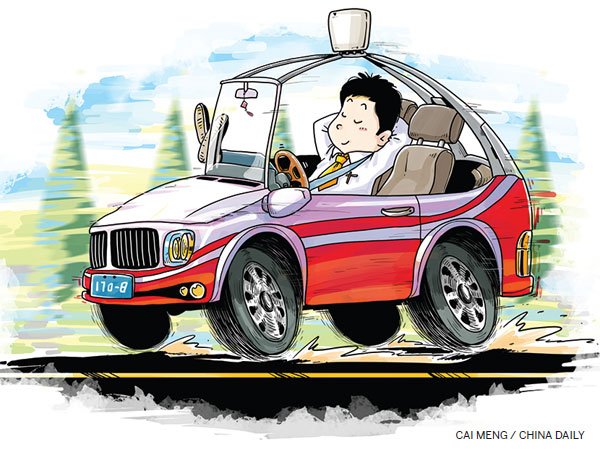The race to get rid of human drivers
Updated: 2016-05-06 10:26
By Paul Welitzkin(China Daily USA)
|
|||||||||
The date on when they will be fully deployed may vary, but companies in China and the US are pushing hard to put autonomous or self-driving vehicles on the road, Paul Welitzkin reports from New York.
Simply put, it's scary: A piece of mobile steel machinery weighing thousands of pounds operating without the guidance of a human. But autonomous or self-driving vehicles, once confined to the minds of science-fiction writers and readers, may be close to becoming a reality.
"We are likely to see autonomous cars that drive at low speeds by 2021 or 2022," said Xavier Mosquet, a senior partner in the Boston Consulting Group's automotive sector and the head of the firm's Detroit office, in an interview. "You already have Google cars that are reasonably autonomous in San Francisco and there are also experiments in Tokyo and Singapore."
Thirteen companies have been given permission to test autonomous vehicles on the roads of California. China's Chongqing Changan Automobile Co said in April it completed a 1,200-mile trip from Chongqing to Beijing testing a self-driving car as part of its campaign to produce highly automated vehicles.
Lex Kerssemakers, CEO of Volvo North America, expects to see self-driving vehicles on the streets of Beijing or New York sometime after 2020. "I think it will come a lot sooner than most are predicting," he said.
China and the US are major players in the race to the vehicles. China seems particularly well suited for self-driving cars. It is plagued by air pollution, traffic congestion and erratic driving. More than 200,000 people die each year in road accidents in China, according to the World Health Organization.

 Canada getting on top of Alberta wildfire, Fort McMurray off limits
Canada getting on top of Alberta wildfire, Fort McMurray off limits
 Young golfers enjoy the rub of the green
Young golfers enjoy the rub of the green
 71st anniversary of victory over Nazi Germany marked
71st anniversary of victory over Nazi Germany marked
 Post-90s girl organizes others’ messy wardrobes
Post-90s girl organizes others’ messy wardrobes
 Landslide hit hydropower station in SE China
Landslide hit hydropower station in SE China
 World's first rose museum to open in Beijing
World's first rose museum to open in Beijing
 Teapot craftsman makes innovation, passes down techniques
Teapot craftsman makes innovation, passes down techniques
 Raging wildfire spreads to more areas in west Canada
Raging wildfire spreads to more areas in west Canada
Most Viewed
Editor's Picks

|

|

|

|

|

|
Today's Top News
Liang avoids jail in shooting death
China's finance minister addresses ratings downgrade
Duke alumni visit Chinese Embassy
Marriott unlikely to top Anbang offer for Starwood: Observers
Chinese biopharma debuts on Nasdaq
What ends Jeb Bush's White House hopes
Investigation for Nicolas's campaign
Will US-ASEAN meeting be good for region?
US Weekly

|

|










